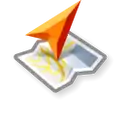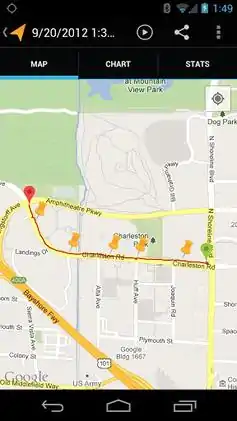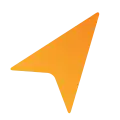MyTracks
MyTracks was a Global Positioning System (GPS) tracking application that ran on Android. The application used a device's GPS capabilities to collect data, allowing real-time review of path, speed, distance, and elevation. Later, this data could be saved to Google Maps, Google Fusion Tables, or Google Docs and shared with Google+, Facebook, or Twitter. The application also allowed a user to record annotations along the path, hear periodic voice announcements of progress, and sync with select third-party bio-metric sensors.
 MyTracks 2.0 Logo | |
Screenshot  | |
| Original author(s) | |
|---|---|
| Developer(s) | |
| Initial release | 12 February 2009[1] |
| Final release | |
| Preview release | 2.0.2.rc6
|
| Repository | |
| Written in | Java, XML (content language) |
| Operating system | Android 1.5+ |
| Size | Varies with device[2] |
| License | Apache License, Version 2.0 |
| Website | www |
In 2016, Google announced that MyTracks would be deprecated and no longer available in the Google Play Store.[2][4] An in-app popup alerted users that MyTracks would stop working on April 30, 2016;[5]
History
The application made its debut on February 12, 2009 under a closed license.[1] A year later on March 28, 2010, Google announced the open-sourcing of the application, stating that "The collective intelligence of the development community will create a more powerful, more intuitive, more useful, and more robust My Tracks."[6] The first major re-haul of the application came on July 13, 2012 when Google released version 2.0. This introduced a new interface, support for playing back data in Google Earth for Android, improved charts, and additional statistics.[7] In 2014 the developers announced on the google code project site that My Tracks would no longer developed in the open and that the source code would be removed.[8] The last open source version was 2.0.5 released in August 2013.[9]
Reception
In September 2013, the Google Play Store listed the application as being installed on 10,000,000 – 50,000,000 devices, with an overall rating of 4.4/5 from over 80,000 reviews.[2] CNET gave the application 4/5 stars, praising its "Chart, Statistics, and satellite playback" and ability to pause recordings but criticized it for an "unattractive interface" and lack of "athletic-specific features".[10] PCWorld awarded MyTracks 5/5 stars, stating "this app is just about perfect. It is intuitive to use and very stable."[11]
Forks
OpenTracks is an open-source fork launched in 2020.
 OpenTracks Logo | |
| Initial release | 19 September 2019.[12] |
|---|---|
| Stable release | v4.0.6[13]
/ 7 August 2022 |
| Repository | |
| Written in | Java, XML (content language) |
| Operating system | Android 5.0+ |
| Platform | Android (operating system) |
| License | Apache License, Version 2.0 |
| Website | opentracksapp |
External links
References
- Shankland, Stephen (February 12, 2009). "My Tracks turns Android phone into GPS device". CNET. Retrieved December 7, 2012.
- "My Tracks". Retrieved December 7, 2012.
- "My Tracks". Jan 30, 2014. Retrieved February 2, 2014.
- "My Tracks no longer available after April 30, 2016 - Google Maps Help". support.google.com. Retrieved 2016-02-06.
- "Screenshot about App discontinuation (German)". Google+. Retrieved 27 January 2016.
- Dornbush, Sandor; Damazio, Rodrigo (May 28, 2010). "Code for My Tracks is now yours". Google Lat-Long Blog. Retrieved December 7, 2012.
- Lardinois, Frederic (July 13, 2012). "Google Launches MyTracks 2.0 GPS App For Hikers, Bikers & Runners". TechCrunch. Retrieved December 7, 2012.
- "My Tracks for Android - Google Project Hosting". Retrieved 2014-06-21.
- "Google Code Archive - Long-term storage for Google Code Project Hosting".
- Cabebe, Jaymar (October 4, 2012). "My Tracks review: Google makes a solid multipurpose GPS tracker". CNET. Retrieved December 7, 2012.
- Rose, Brent (September 14, 2010). "My Tracks". PCWorld. Retrieved December 7, 2012.
- "OpenTracks v3.0.0". GitHub. Retrieved April 17, 2022.
- "OpenTracks v4.0.6". GitHub. Retrieved August 7, 2022.